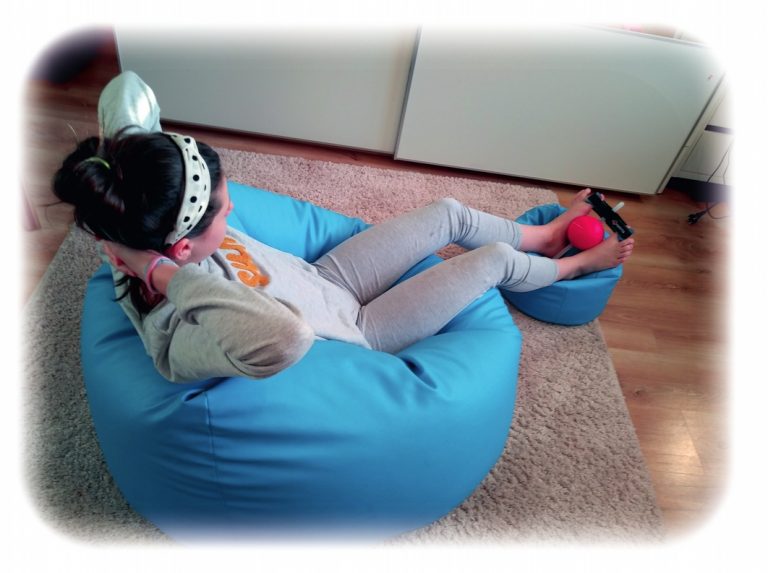Basic level exercises
Exercise 1: Passive-dynamic correction, stretching big toes.
Starting position*:
Sitting position, the plantar side facingthe floor. Big toes inserted into loops. Heels based on the floor. The internal side of the feet surrounds the ball.
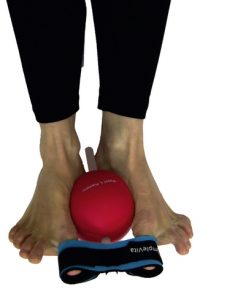
Description of the exercise:
Move the internal side of both heels closer to the rod. Try to touch them together. Adjust the loop diameters so that after joining the heels you feel a slight stretching of the adductor hallucis muscles (big toes pulled towards the rod and away from the second toes).
Hold the heels together for 6-8 seconds. Then pause the exercise for about 10 s and relax your foot muscles.
Number of repetitions: 10-15
In this exercise, in the initial phase (until the moment of starting squeezing the ball), the adductor muscles of the big toes are passively stretched. In the passive phase, an anty-valgus (varus) force is generated of both big toes based on a lever mechanism with a support point at the level of the first metatarsal heads.
Further approaching the heels (dynamic phase) towards the rod up to their connection causes the elastic ball to squeeze, which in turn generates the resistance and strengthening force of the big toes abductor muscles.
Exercise 2: Passive-dynamic correction with active alternating flexion and extension of the big toes.
Starting position*:
Sitting position, the plantar side facing the floor. Toes inserted into the loops. The heels based on the floor. The internal side of the feet surrounds the ball. The rod in the middle position of the body.

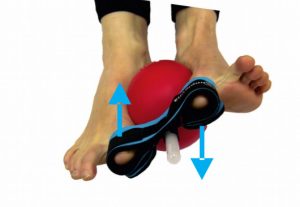
Description of the exercise:
Move the internal side of both heels closer, try to touch the rod by them. Adjust the loop diameters so that after joining the heels you feel a slight stretching of the adductor hallucis muscles (big toes pulled towards the rod and away from the second toes).
Then point the big toe of the right foot up (dorsiflexion) and the left big toe down (plantarflexion). The big toes should be in a stretching position at all times.
Then point the right big toe down and the left big toe up.
Make these movements alternately 6 times and then relax your foot muscles for about 10 s.
Number of repetitions: 5-10
In this exercise, along with the adductor hallux muscle stretched on both sides -gradually being restored the balance between the long flexor of the big toe and its extensor and their physiological course. In addition, interosseous and lumbricales muscles responsible for the proper transverse arch of the foot are strengthened.
Exercise 3: Dynamic big toe correction
Starting position*:
Sitting position, the plantar side facing the floor. The big toes inserted in loops. Floor-based heels. The inside of the feet surrounding the ball.
Get closer to the medial side of the heels, try to touch them at the height of the rod. Loop diameters should be chosen so that after joining the heels you feel a slight stretching of the adductor muscles (the big toes pulled towards the rod and away from the second toes).
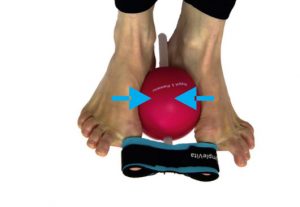
Description of the exercise:
Move your feet together, squeezing the ball with the inside of your feet.
Try to keep the ball squeezed for a few seconds, then return to the starting position for about 5-10 s. Exercise is like closing and opening a circinus.
Number of repetitions: 5-10
In this exercise, there is dynamically strengthen the abductor hallucis muscles within the medial eminence of the feet.
Muscles are also activated in other parts of the lower limbs (not only feet) important for proper dynamics and statics of the feet.
Tip:
Loops may loosen in this exercise. This is the correct situation.
Exercise 4: Dynamic correction of longitudinal feet arches
Starting position*:
Sitting position, big toes inserted intothe loops. The plantar sides of the feet facing each other surround the ball (feet in supination). A rod in the median plane of the body.
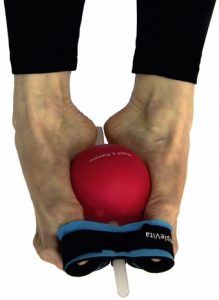
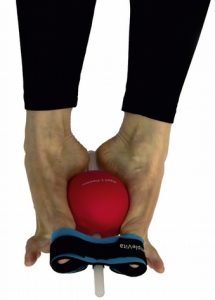
Description of the exercise:
Try to get your feet closer, squeezing the ball. Try to keep the ball squeezed for a few seconds, then return to the starting position for about 5-10 s.
Than try to get your feet closer without squeezing the ball, and then move the big toes apart, trying to tension the toe loops.
Number of repetitions: 5-10
The components of the “tendonous stirrup” are dynamically strengthened in this exercise. The balance between peroneus longus muscle and posterior tibial muscle is restored and also between peroneus brevis muscle and tibialis anterior muscle.
The extensor hallucis longus muscle and from the inside of the foot the abductor hallucis muscle are also strengthened.
A longitudinal arch (flatfoot correction) and transverse arch (correction of the transversely flat foot and hallux valgus) are formed. The medial head of the calf triceps muscle is also strengthened by reducing the valgus heel position (correction of the flat-valgus foot).
*Basic exercises can be done lying down. Then the starting position is the supine position – heels base on the floor, feet perpendicular to the floor.
